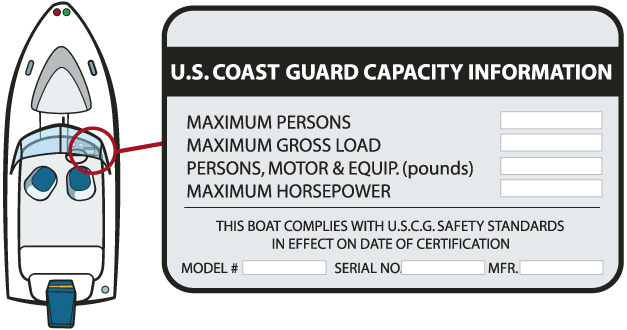Boat Capacity
One of the most important things you need to know before setting out on the water is the maximum number of people and maximum amount of weight that your boat can safely handle. Not only is this an important safety concern, it's also the law.
Federal Law mandates that all powerboats less than twenty feet in length need to carry this information in the form of a Capacity Plate.
Each Capacity Plate includes the maximum number of adult persons, the maximum gross load, and the maximum size of engine, in horsepower, that your boat can legally carry.
The next time you're around a boat, look for its Capacity Plate; it should be permanently fastened near the steering area, or the helm.

Before any boat trip, you'll want to make sure that you are not taking more people onboard than is indicated by the Maximum Person number, and that you don't have more total weight than is indicated by the Maximum Gross Load. The Maximum Gross Load is the total weight your boat can handle, including people, equipment, stores, fuel, engine assembly and steering controls. If your boat doesn't have a Capacity Plate, you can calculate the number of people you can safely take onboard using the following equation.
Boat Capacity Calculation
If your boat doesn't have a Capacity Plate, you can calculate the number of people you can safely take onboard using the following equation and calculator.
Number of people = vessel length (ft.) x vessel width (ft.) ÷ 15
First, find out the length and width of your boat in feet, then use our calculator to find out your boat's capacity.
Note that personal watercraft do not have a capacity place. For P-W-C's, always follow the recommended capacity in the owner's manuel and on the manufacturer's warning decal.
Finally, the Capacity Plate will also indicate the maximum engine power for your boat, given in horsepower. This number applies only to boats powered by outboard engines; and it must never be exceeded.
Maximum Person Capacity
There are a number of variables that boat manufacturers consider when determining the maximum person capacity that appears on your Capacity Plate.
One of those variables is the weight of each person.
Boat manufacturers typically use an average weight of about one hundred and fifty pounds per person to calculate maximum capacity. It can be a little more or a little less, but if some or all of your passengers weigh over one hundred fifty pounds, you may have to decrease the number of passengers you can safely take on board.
Remember, the maximum person capacity is a guideline that you have to adjust given the weight of your passengers and the other supplies you are taking on board.
If you are carrying heavy equipment, you may have to further reduce the number of passengers.

Maximum Horsepower
If you don't have a capacity plate on your boat—which may be the case if you're operating a small, flat-bottomed boat—you can calculate the largest safe engine size in the following way.
Maximum Horsepower Calculation: Boat length x boat width = boat square footage
First, find out the square footage of your boat by multiplying its length by the width of the transom.
Remember, the maximum person capacity is a guideline that you have to adjust given the weight of your passengers and the other supplies you are taking on board.
Then use our calculator and the table here, to find out your boat's maximum horsepower. For example, a twelve-foot boat with a four-foot transom width translates into a maximum engine size of fifteen horsepower.
| Length x Width | Max Horsepower |
|---|---|
| 35 feet or less | 3 |
| 36 - 39 feet | 5.5 |
| 40 - 42 feet | 7.5 |
| 43 - 45 feet | 10 |
| 46 - 52 feet | 15 |
Overloading or Overpowering
Either overloading or overpowering your boat is extremely dangerous.
Putting an over-sized engine on your boat will cause your boat to sit too low in the stern, and that will make it much more susceptible to being swamped by its own wake or that of a passing boat. An overpowered boat is also hard to control.
What about overloading your boat? Overloading your boat, either with too many people or too many supplies, also makes your boat susceptible to swamping.
Even if you are within the maximum allowable weight, make sure that you distribute the load evenly, focusing the weight in the middle of the boat. This will keep your boat stable in the water and help prevent capsizing or swamping.
Finally, remember that in bad weather, you must be extra careful about how much weight you take in your boat. With higher waves, a heavy boat is harder to control and more susceptible to being swamped. Stay safe. Follow the guidelines for load capacity and always adjust for bad weather.

Beware of bad weather! Take much lighter loads in poor weather conditions to ensure boat stability.
